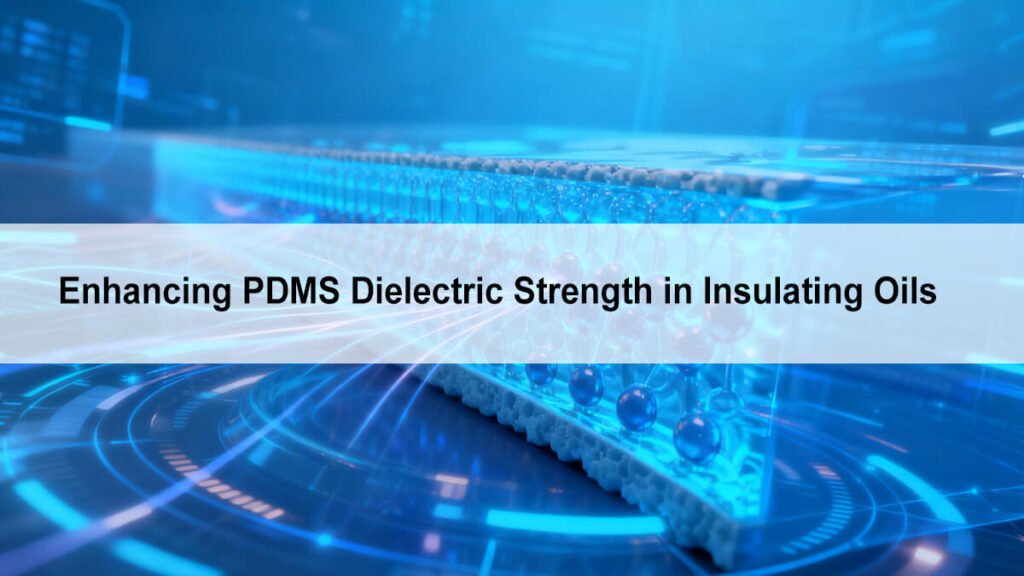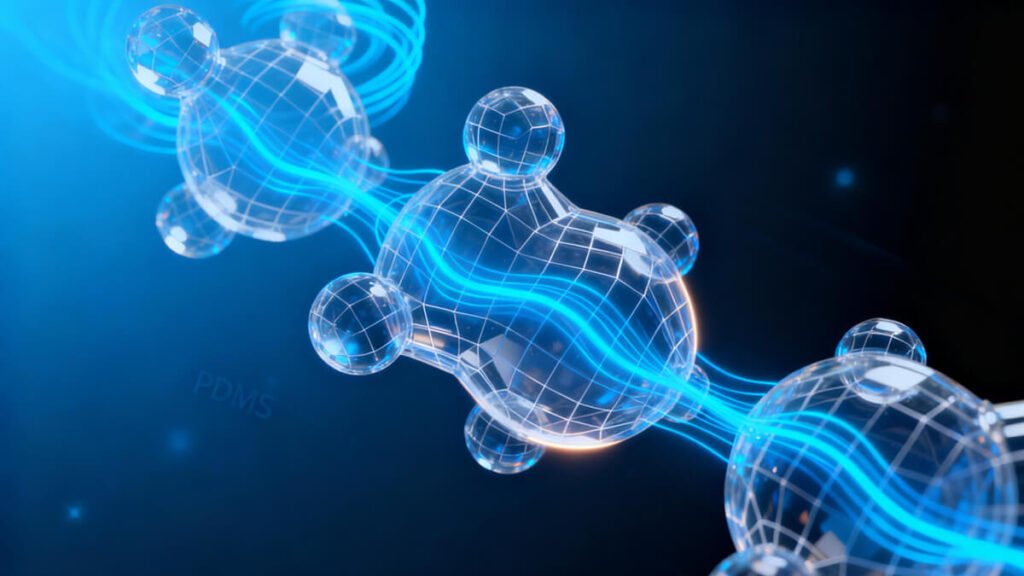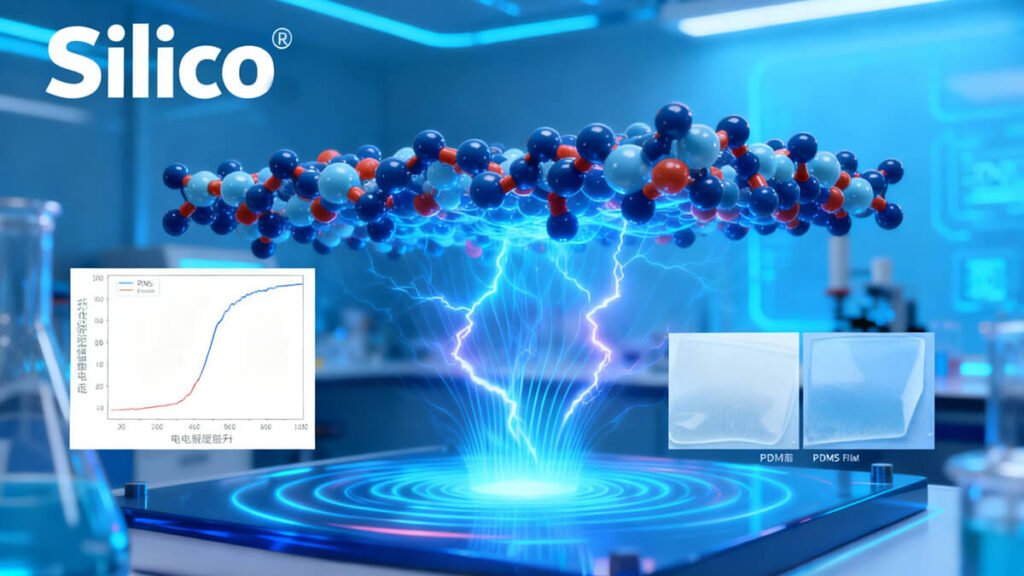Enhancing PDMS Dielectric Strength in Insulating Oils
- Blog
- December 6, 2022
- 4:39 pm

In high-voltage systems such as transformers, switchgear, and capacitors, liquid insulating oils play a critical dual role — providing electrical insulation and transferring heat.
Traditional mineral oils face limitations in oxidation stability, moisture tolerance, and fire safety. Polydimethylsiloxane (PDMS), as a silicone-based insulating fluid, offers a superior alternative with high thermal stability, chemical inertness, low dielectric loss, and broad operational temperature range.
For example, a 50 cSt PDMS silicone oil demonstrates breakdown voltages up to 50 kV, highlighting its potential as a next-generation dielectric medium.
Table of Contents
- 1. Understanding the Fundamentals
- 2. Benefits and Challenges of PDMS-Based Insulating Oils
- 3. Key Factors Affecting Dielectric Strength
- 4. Proven Methods to Enhance Dielectric Strength
- 5. Research Insights and Industrial Applications
- 6. Recommendations for Silico® PDMS Insulating Oils
- 7. Conclusion and Future Trends
1. Understanding the Fundamentals
What Is PDMS (Polydimethylsiloxane)?
- High electrical resistivity
- Low dielectric loss
- Hydrophobic and oxidation-resistant properties
Role of Liquid Electrical Insulating Oils
- Prevent arcing and corona discharge between conductors
- Cool components such as coils and cores
- Suppress partial discharges and delay dielectric breakdown
Definition of Dielectric Strength and Its Importance
Dielectric strength (or breakdown voltage) represents the maximum electric field a liquid can withstand before electrical failure. It directly determines the safety margin and reliability of high-voltage equipment.

2. Benefits and Challenges of PDMS-Based Insulating Oils
Advantages
- Superior thermal stability and oxidation resistance
- High breakdown voltage (~50 kV) and low dielectric loss (tan δ < 0.0001)>
- High flash point (~300 °C) for improved fire safety
- Eco-friendly, non-toxic, and recyclable
Challenges
- Impurities, microbubbles, and water contamination reduce breakdown strength
- Poor dispersion or filler instability leads to localized discharge
- Interface degradation and moisture ingress accelerate aging
3. Key Factors Affecting Dielectric Strength
| Factor | Impact | Optimization Strategy |
|---|---|---|
| Purity | Impurities cause discharge initiation | Use ultra-pure PDMS base fluids |
| Bubbles / Voids | Create localized field enhancements | Apply vacuum degassing & slow filling |
| Moisture | Reduces resistivity and breakdown voltage | Maintain ≤ 50 ppm water content |
| Filler Dispersion | Agglomeration causes field distortion | Use silane-treated nano-fillers |
| Temperature & Aging | Promotes degradation and gas formation | Monitor viscosity & electrical loss |
| Electrode Geometry | Influences local field stress | Employ smooth electrodes & standardized test setups |
4. Proven Methods to Enhance Dielectric Strength
High-Purity PDMS + Vacuum Degassing
Incorporating Nano-Fillers
Interface Modification
Process Optimization
Aging Control & Monitoring
Establish oil testing schedules (breakdown voltage, resistivity, tan δ, moisture). Replace or regenerate oils based on predictive condition analysis.
5. Research Insights and Industrial Applications
PDMS in Transformer Applications
- Breakdown voltage ≈ 50 kV
- Resistivity ≈ 1×10¹⁴ Ω·cm
- Moisture < 50 ppm
- Flash point ≈ 300 °C
Nanocomposite Innovation

6. Recommendations for Silico® PDMS Insulating Oils
Product Specification Targets
- Base Fluid: PDMS (20–50 cSt, ≥ 99.9% purity)
- Water Content: ≤ 50 ppm
- Breakdown Voltage: ≥ 50 kV (ASTM D877)
- Volume Resistivity: ≥ 1×10¹⁴ Ω·cm
- Flash Point: ≥ 300 °C
- Dielectric Loss (tan δ): ≤ 0.0001
Production & Quality Control
- Vacuum dehydration and degassing under inert gas
- Inline filtration (< 1 µm)
- Batch certification with MSDS/TDS download available
- Traceability and lifecycle data tracking
7. Conclusion and Future Trends
As electrical systems move toward higher voltages, compact designs, and greener operation, PDMS-based silicone insulating oils will play a pivotal role.
Through advanced purification, nano-modification, and optimized system design, Silico® can pioneer the next generation of high-dielectric-strength insulating oils — delivering exceptional safety, performance, and environmental value.
Popular Recommendations
Get a Catalog & Best Price
- Quick and helpful reply within 24 hours;
- Tailored solutions provided for your project;
- One-stop purchasing service.
TRENDING
Silico® ORGANOSILICON
- Address: Daiyue Industrial Area, Taian, Shandong, China
